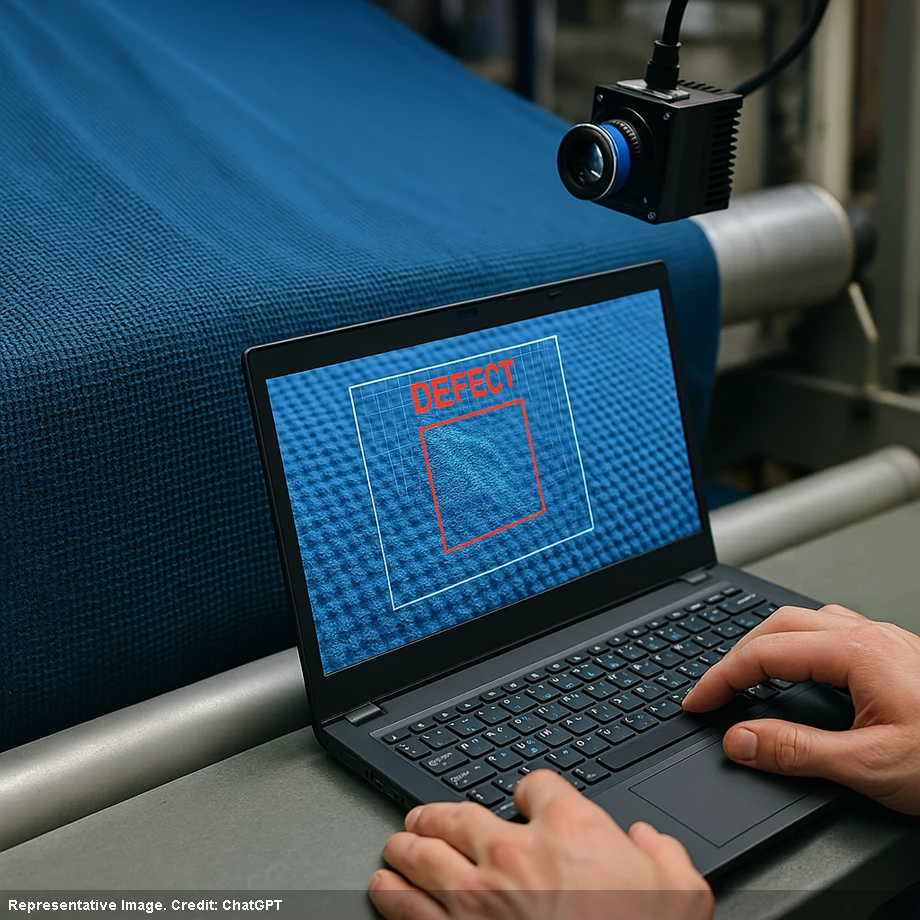
Category: TECHNOLOGY AND INNOVATION
Country: India
By CO-EDP
VisionRICO-EDP, VisionRI
05th April 2025 18:06 IST
Artificial intelligence is revolutionizing quality control in the textile industry through advanced defect detection systems. Yet the full potential of this technological shift remains hindered by high implementation costs, limited data access, and integration challenges, reveals a new study published in the journal Textiles.
The study titled “Artificial Intelligence Driving Innovation in Textile Defect Detection,” was conducted by researchers from Pamukkale University and Aydın Adnan Menderes University in Türkiye. Drawing from a comprehensive review of traditional methods, machine learning algorithms, and deep learning innovations, the authors argue that AI can replace unreliable manual inspection and enable scalable, high-precision quality control. However, they also caution that real-time defect detection at scale demands significant capital investment, vast labeled datasets, and computational infrastructure that many textile manufacturers, particularly small and mid-sized firms, still lack.
Can traditional inspection methods meet modern textile quality demands?
For decades, the textile industry has relied on human visual inspection for quality control. While experienced operators can detect certain types of defects, the method suffers from well-documented limitations: human error, fatigue, inconsistent judgment, and inefficiencies in high-speed production environments. The study outlines how these weaknesses are amplified by the complexity and variability of modern textile production, which includes a wide range of defects across fibers, yarns, weaving, knitting, dyeing, and finishing.
Mechanical and optical systems have partially mitigated these issues. Examples include mechanical sensors for yarn breakages and optical systems that detect color mismatches and structural inconsistencies. However, such systems typically perform well only under controlled conditions and can struggle to distinguish subtle defects in patterned or textured fabrics. The researchers identify that combining mechanical and optical systems offers improved results but still fails to fully meet the real-time demands of modern mass production.
AI and computer vision have emerged to fill this performance gap. Integrated with high-resolution, hyperspectral, and line-scan cameras, AI systems now enable continuous real-time monitoring, automated defect classification, and predictive alerts. This results in faster defect identification, reduced rework, and enhanced product consistency. But the effectiveness of these systems depends heavily on the underlying algorithms and the quality of the training data.
Which AI technologies are transforming textile defect detection?
The study offers a detailed evaluation of machine learning and deep learning techniques used in textile quality control. Traditional machine learning models like Support Vector Machines (SVMs), Random Forests (RFs), and Markov Random Fields (MRFs) have been widely adopted for classifying defect types based on features like texture, color distribution, and pattern irregularities.
Random Forests, for instance, are known for their low bias and high interpretability, offering effective classification even in noisy or unbalanced datasets. MRFs, on the other hand, excel at capturing spatial dependencies, making them ideal for complex pattern analysis. However, both models face scalability challenges when dealing with high-resolution image data from real-world industrial environments.
Convolutional Neural Networks (CNNs) have emerged as the dominant solution in recent years. Their ability to learn spatial hierarchies directly from image data allows them to outperform traditional models in detecting subtle surface anomalies. According to the study, CNNs trained on benchmark datasets have achieved defect detection accuracy ranging from 80% to 95%. Hybrid systems that combine CNNs with traditional classifiers further boost accuracy by refining feature extraction and classification stages.
Still, the study warns that most accuracy figures are derived from laboratory settings or benchmark datasets, which may not translate to uncontrolled industrial environments. Deep learning models require large, diverse, and well-labeled datasets—often exceeding 10,000 samples—to generalize effectively. Few textile manufacturers have access to such datasets, limiting widespread adoption.
What barriers and future strategies shape the deployment of AI in textiles?
Despite its promise, AI adoption in textile defect detection remains uneven due to several barriers. High implementation costs for high-resolution cameras, GPUs, and training infrastructure deter smaller firms. Computational load is another concern, especially for systems that must process large volumes of image data in real time. The authors note that high-speed camera setups and deep learning models require significant optimization to prevent system lag, particularly in continuous production lines.
Looking ahead, the authors envision a future where AI fully integrates with Industry 4.0, ushering in smart manufacturing. Internet of Things (IoT)-enabled real-time monitoring, cloud computing, and predictive analytics could preempt defects before they occur, shifting quality control from reactive to proactive. Hybrid AI models blending deep learning with traditional methods promise even greater accuracy, leveraging CNNs for pattern detection and Random Forests for refined classification.
In terms of sustainability, AI-powered defect detection offers significant gains. Early detection reduces waste, improves raw material utilization, and minimizes energy consumption by avoiding production overruns and reprocessing. The study estimates that AI-driven systems can reduce fabric waste by approximately 20% in large-scale operations, supporting both cost efficiency and environmental goals.
However, realizing these benefits requires strategic alignment with international quality and monitoring standards. The study calls for compliance with ISO 18436-8 (condition monitoring) and ISO 9001 (quality management) to ensure that AI systems operate within globally recognized performance frameworks.
The study also calls for interdisciplinary collaboration between AI developers, textile engineers, and production managers. Without this coordination, even the most advanced technologies risk failing to deliver practical value on the factory floor.
Courtesy: devdiscourse.com
Copyrights © 2026 GLOBAL TEXTILE SOURCE. All rights reserved.